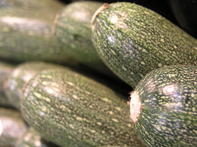
Scientific name: Cucurbita Pepo
Common Name: Courgette, Zucchini, Marrow or Baby marrow.
Plant Description
The courgette plant is of the cucurbit family and consists of slightly trailing stems with large, hairy, dark green leaves.
It is a summer squash and has a more bush-like plant form than the common wide trailing manner of winter squash. The male flowers appear on the stems first. The female flowers bloom slightly later and have slightly bulbous bases, which develop into the courgette fruit. The stems can extend about 1000 mm from where the seed or seedling is planted.
Courgettes are a relatively quick crop and can be harvested from as early as eight weeks from the planting of seeds. The plant is more bush like than the other trailing squash cucurbits and can, therefore, be planted more densely.
Uses
Courgettes are most commonly eaten at their immature stage when they are about 12 cm to 15 cm long as baby marrows or zucchini.
They can also be left on the vine and picked later when they are about 40 cm to 50 cm long as marrows, however, this is rare as the skin hardens and the flesh becomes stringier, this also slows growth and reduces the formation of flowers and therefore less fruit will be harvested.
Courgettes can be fried, steamed, roasted and pickled. The fruit and flowers are added to salads, eaten on their own as a vegetable or are also added to stews and casseroles. They are also very tasty and crunchy eaten raw. They can be mulched and made into courgette bread and courgette fried or grilled cakes.
Soil Requirements and Preparation
Courgettes like well-drained soil with a high content of organic matter. The pH of the soil should be slightly acidic between 6 and 7.
The soil must be prepared as per the soil sample results. About six weeks before planting till the soil to 500 mm. This will normally entail the ploughing in of previous crop residue or green compost cover crop, additional compost or manure, lime if the pH is below 6 and superphosphates if required. In the final week before planting, disc harrow the soil to 200 mm, levelling the soil and killing any weeds that may have started to grow.
If planting on raised beds, then draw the raised beds with the appropriate harrow. Apply any trace element requirements and a second run with a disc harrow should follow to further prepare the topsoil and break any clods in the soil. If courgette seedlings are to be planted add pre-harvest fertilizer and disc this into the top 20 cm of the plant row.
Climate
Courgettes are a summer, warm climate crop that is normally cultivated from early spring to midsummer. In the northern summer rainfall areas of South Africa, it is cultivated throughout the year where there are not heavy frosts during winter. The best-growing temperature for courgettes is between 20°C and 24°C. Higher temperatures than this hasten foliage growth rather than flower production. Good germination of courgette seeds requires temperatures to be above 12°C.Cultivars
There are many cultivars and new F1 Hybrids that have been developed over time with different attributes. It is best to seek advice from the buyers as to the consumer’s preference and from the local extension officers and seed specialist as to the best varieties for the growing conditions.
Some varieties that are produced are: Caserta, Cigal, golden butter, green tiger, Mira, monitor, Nero Milan, northern star, star 8021, star 8023, star 8024 and Tromboncino.
By Louise Brodie